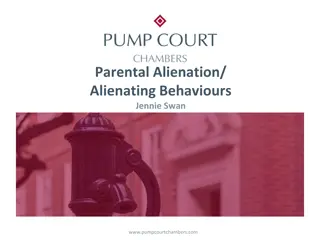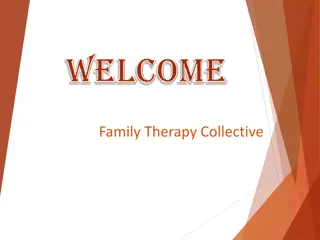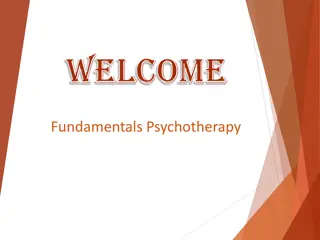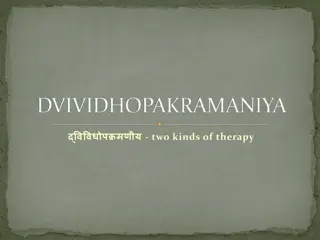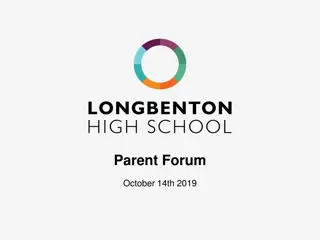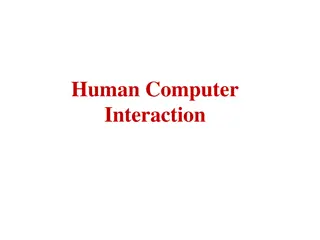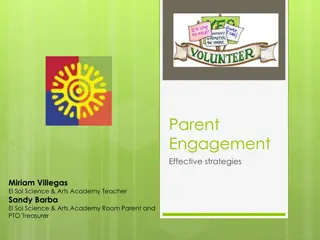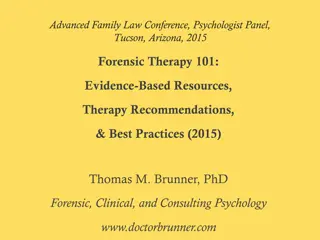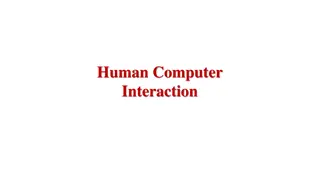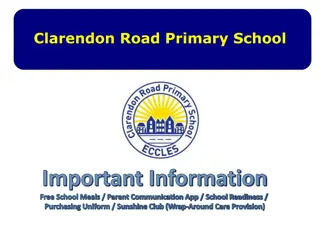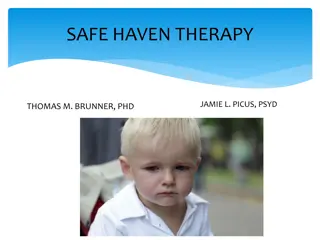Parent-Child Interaction Therapy (PCIT) Overview
Parent-Child Interaction Therapy (PCIT) is an evidence-based practice widely used to address disruptive behavior in young children. Developed in the 1970s by Dr. Shelia Eyberg, PCIT has gained international recognition and is offered in various countries. It combines elements of attachment theory, play therapy, behavior modification, and parenting styles to improve child behavior and parent interactions. PCIT has shown significant results in reducing non-compliance and behavior problems in children, while also enhancing parental confidence and control.
Download Presentation

Please find below an Image/Link to download the presentation.
The content on the website is provided AS IS for your information and personal use only. It may not be sold, licensed, or shared on other websites without obtaining consent from the author. Download presentation by click this link. If you encounter any issues during the download, it is possible that the publisher has removed the file from their server.
E N D
Presentation Transcript
Parent Child Interaction Therapy-PCIT Andrea Carpenter, LPC Certified PCIT therapist and Level 1 Trainer
Learning Objectives What is PCIT? Background of PCIT Research to support PCIT Appropriate clients/families Overview of PCIT services Adaptions for PCIT Certification in PCIT
Acknowledgements Erin Sewell, LCSW- Level 2 trainer- Oregon Melanie Nelson, Ph.D- Master Trainer- Florida John Paul Abner, Ph.D- Master Trainer- Tennessee
PCIT-Background Developed in the 1970 s by Dr. Shelia Eyberg Training started in Florida using a co- training/mentor style Continued to disseminate across labs and clinical trials Has expanded Nationally and Internationally
Background cont. Countries offering PCIT Australia Canada Cyprus Denmark France Germany Hong Kong Indonesia Jamaica Japan Lebanon Netherlands New Zealand Norway Singapore South Korea Switzerland Taiwan
Background cont. PCIT is one of the prominent evidence- based practices (EBPs) and empirically supported treatments (ESTs) world-wide for young children with disruptive behavior problems.
Background cont. Pulls from Attachment Theory (Bowlby) Play Therapy Behavior Modification (Operant Conditioning- Skinner) Parenting Styles (Baumrind) Social Learning Theory (Skinner) Coercive Cycle- (Patterson)
Outcomes Child: Significant reductions in non-compliance and behavior problems Skills are extended/Generalization to home and school
Outcomes cont. Parental: Changes in parents interactional style Parents report less personal distress and more confidence in their ability to control their child s behavior Generalization to siblings
PCIT-Core Features Direct Coaching with the parent & child Restructuring parent/child interactions Assessment driven Sensitivity to developmental concerns Intervening early Targeting a range of behaviors patterns of interaction rather than discrete behaviors Positive, non-judgmental philosophy
Treatment Length of treatment Typically 12-15 weeks Siblings referrals Identify the target child Comorbid diagnoses
Research-Diverse backgrounds Researched to be effective with a diverse group of backgrounds. Mexican-American African American Native American Puerto Rican Australian Dutch Chinese Norwegians Germans Russians Japanese
Client referral/Appropriate clients Children ages 2-7 Diagnosis including disruptive behaviors At least 1 caregiver Strongly encourage 2 if possible Caregiver must have IQ over 75 Child has receptive language above 2 years Therapist fluent in family s native language
Case Examples 6 year old boy- living with his aunt 5 year old girl- parents separated 6 year old girl- living with father 3 year old boy- living with mother
Reasons for PCIT referral Presenting Concerns- Child Temper tantrums Doesn t listen or has difficulty following instructions Aggressive behaviors Preschool having difficulty managing behaviors Presenting Concerns- Parent Child won t listen to them Suspended/expelled from school/daycare Conflict between parents
Referral cont. Disruptive Behaviors Relationship Problems Conduct Problems Lying Hyperactivity Verbal aggression Classroom conduct problems Angry, resentful, spiteful Defies authority Whining Mild noncompliance Bonding in blended families Post-divorce adjustment Low self-esteem Physical aggression Cruelty to animals Destructive behavior Fire-setting Stealing Continuum of Severity
Typical Diagnoses Adjustment Disorder ADHD Depression Anxiety PTSD ODD Autism Spectrum Disorder
Treatment Overview Balances Two Factors 1. Positive Interaction with the Child Increase positive attention Decrease negative attention 2. Consistent Limit Setting Consistency Predictability Follow-Through
Components of Treatment Child Directed Interaction (CDI)- attachment building Attachment Parent shapes behaviors Build pro-social skills
Components of treatment cont. Parent Directed Interaction (PDI)- Effective Discipline Structured Consistent Uses parental attention rather than material rewards or punishment Use time out for non-compliance Establishing house rules
Treatment cont. Homework 5 minutes per day Really important for parents to practice skills daily to learn They must have access to their child to practice the skills minimum 3 days a week Use the ECBI (Eyberg Child Behavioral Inventory) to track parents report on child s behaviors
Treatment cont. Set up in office: Parent and Child in one room One- way mirror Ear buds Select toys Data tracking sheets
Child Directed Interaction CDI Skills- Attachment Building PRIDE P- Praise R- Reflect I- Imitate D-Describe E- Enjoy
Child Directed Cont. Don t skills Questions Commands Negative Talk Ignoring the negative and praising the positive opposite
Parent Directed Interaction PDI Skills- Effective Commands Direct vs Indirect Specific Positively stated- what to do vs not do Developmentally Appropriate One at a time Neutral tone of voice Explanation given before command or after compliance Only when necessary
PDI cont. Teach the parents how to follow through to help child be better at listening the first time Use time out to manage non-compliance Start with using easy commands and gradually work to harder commands Work at child and parents pace to ensure confidence
PDI cont. Time out is a result of child not following directions Focus on 5 seconds of quiet to end time out Ends with them following through with the original command to teach child to follow directions the first time Focus on supporting parent in following through until the end rather than giving in
PCIT during Covid-19 Previously research has been doing on internet based PCIT Offered in a variety of ways Part in office part at home Fully at home In a separate clinic from where clinician was located
Covid-19 cont. Computer screen Phone/telehealth platform Services still able to take place organically Troubleshoot in the home Easier to address real life behaviors Lower drop out
After treatment Continued improvement following graduation Often don t need other treatment Can be referred for more specific treatment such as TF-CBT if needed Booster sessions
Certification Master s degree or higher 40 hours of training Different criteria for type of training based on the trainer experience Graduate 2 cases using PCIT protocol Must remain on consultation calls until the 2 cases have been completed to graduation Skills checked off Apply to become a certified PCIT therapist (PCIT international) Pass the PCIT Certification Experience test
Adaptations PCIT- Toddler PCIT with older kids PCIT with kids on the Autism Spectrum PCIT- Selective Mutism Internet based PCIT TCIT- Teacher Child Interaction Therapy
Resources McNeil, C. B., Hembree-Kigin, T. L., & Anhalt, K. (2011). Parent-Child Interaction Therapy (Issues in Clinical Child Psychology) (2nd ed. 2010 ed.). Springer. www.PCIT.org





